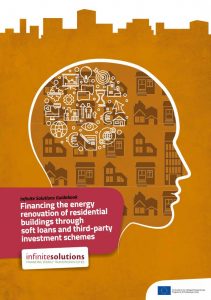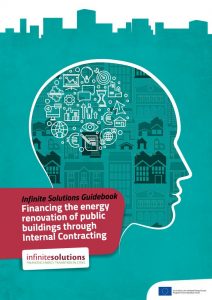The Brussels Capital Region has established ambitious energy and climate goals. It is on the way to reducing its CO2 emissions by 20% by 2020 while aiming to achieve a 30% reduction by 2025 and 80 to 90 % C02 reduction by 2050. In 2016, the Region developed an Energy, Climate and Air Protection Plan (PACE). Buildings which are responsible for 70% of energy consumption play a central role in this plan and other policies developed at the regional level.
Lack of attractive financing for homeowners with very low to medium incomes. In Brussels Capital Region, commercial banks offer the following two types of loans to finance housing energy retrofits:
– A consumer loan which usually has a maturity of 10 years and relatively high interest rates of 3 to 10%.
– A mortgage that can include energy renovation costs. Interest rates are
lower than for a consumer loan but the maturity is usually the same (10 years). The current average interest rate for a mortgage varies between 1.5% and 3%.
The Region and some of the municipalities offer financial incentives to encourage citizens to carry out energy renovation work in their homes such as:
– ‘Energy grants’ for energy retrofit work (energy audits, insulation,
ventilation and heating systems) that meets ambitious energy objectives set by the region. The level of ambition is related to the Energy Performance of Buildings Directive (EPBD) which sets a minimum standard for insulation.
– ‘Renovation grants’ which can finance any work related to the renovation of a building such as scaffolding, façade rendering and electrical installation renovation.
Although the Region offers incentives to citizens such as technical assistance and grants, some of them face difficulties with pre-financing the work. Homeowners can often finance up to 50% of renovation work via grants, however, they receive the grants only once the renovation works are finalised and paid for. Many homeowners, in particular those on very low incomes, are unable to pay all the invoices upfront and/or they do not have enough money in their bank accounts to pay for the rest of the investment (not covered by grants). Moreover, people with low and very low incomes may not be eligible for existing loans offered by commercial banks because the risk for the banks
is too high.
Solution
The Brussels Capital Region decided to launch a Brussels Green Loan, a zero to low interest loan which helps homeowners to pre-finance energy renovation work.
Homeowners have a choice between:
1- A short-term consumer loan with an interest rate of 0% or 1% which they have to reimburse in up to 10 years.
This loan is offered by Crédal, a financial cooperative that aims to promote a fairer and more supportive society.
2- A long-term mortgage with a personalised interest rate between
0% and 2% which needs to be reimbursed within a max. of 30 years.
Long maturity results in lower monthly installments.
This loan is offered by the Housing Fund (Le Fonds du Logement/Woningfonds) of the Brussels Capital Region which is a cooperative company. Its objective is to defend access to housing rights.
Interest rates depend on the homeowner’s income but are very advantageous in every case.
The added value of the Brussels Green Loan is that even low and very low income households and people with no access to commercial loans are eligible. Crédal and the Housing Fund’s core business is to support citizens in their project of buying a home and provide them with loans.
The Brussels Capital Region’s target is to issue 700 loans in 2017.
Homeowners’ advantages
Technical assistance
- Homeowners with an energy renovation project go to the Energy House. They get initial advice and recommendations on potential energy saving measures and existing technologies. Their personal situation is partly analysed and they receive information about grants and financing solutions for which they are eligible. At this stage, the energy advisor can visit their homes and check on the spot which measures can be carried out.
- Homeowners are responsible for finding craftsmen and architects and getting quotes.
- The Energy House advisor checks the quotes and official documents presenting the home owner’s personal and financial situation. They check whether the households and the proposed measures are eligible for grants, the Brussels Green Loan and other financing instruments.
- When homeowners wish to apply for a loan, an appointment is made with the financial institution which issues the loan.
*yearly indexed
Financing scheme highlights
| Strong points | Weak points |
| – Tailor-made advice for homeowners – Attractive interest rate (0-2%) – Accessible to low and very low income families – Very low risk (1 case since 2008) – Ambitious energy efficiency targets to obtain grants | – Expensive for the Regional budget – Time-consuming for the bank advisors to carry out a financial check and provide information to homeowners (on average 16.5 hours for Crédal). – Risk borne by the Region – Absence of a procedure to monitor the results in terms of CO2 emission reduction – The fact that two lenders are involved in the financing scheme makes it more difficult to set up simple common procedures and conditions – The Brussels Environment internal communication team does not have the expertise to communicate on financial issues – A substantial number of people involved: can slow down the process |
Recommendations
– Keep your financing mechanism simple and easy to understand.
– Keep the mechanism easy to manage, monitor and follow.
– Make sure you have a visible and efficient front office.
– Carry out a professional communication campaign.
– Think in advance about how to monitor the effect of investment in terms of CO2
emissions
Next steps:
The Region intends to:
– Increase the amount of loans issued by reinforcing its communication campaign.
– Investigate options on how to increase the renovation rate of condominiums through specific technical assistance and a
financing instrument.



